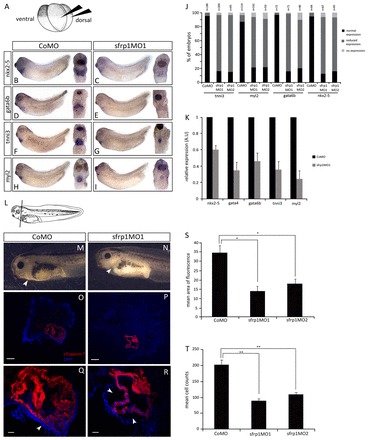Fig. 3.

Loss-of-function experiments show that endogenous sfrp1 is required for formation of a normal size heart. (A) For sfrp1 loss-of-function experiments, MOs were injected into the marginal zone of both dorsal blastomeres at the 4-cell stage. (B-I) WISH analysis on stage 32 embryos indicating the expression of cardiac-specific marker genes. Control embryos injected with CoMO showed normal expression of cardiogenic transcription factor (B,D) and myocardial differentiation marker (F,H) genes. By contrast, embryos injected with sfrp1MO1 (C,E,G,I) revealed a loss of cardiogenic transcription factor gene expression and a reduced expression domain of myocardial differentiation marker genes. (J) Quantification of WISH of heart marker gene expression showing reduced expression in sfrp1MO1- and sfrp1MO2-injected compared with CoMO-injected embryos. (K) qPCR analysis on MO-injected embryos at stage 32 showing reduced cardiogenic gene expression in sfrp1MO1-injected embryos relative to controls. (L) Schematic of a stage 41 embryo indicating the orientation of sections in O-R. (M,N) Phenotype of stage 41 MO-injected embryos after terminal differentiation. CoMO-injected embryos (M) show a normal size heart within the pericardial cavity (arrowhead). sfrp1MO1-injected embryos (N) show reduced heart size (arrowhead) within a relatively empty pericardial cavity. (O-R) Terminal differentiation of the heart was analysed in stage 41 embryos by immunofluorescence for cardiac Troponin T (cTnT, red) with DAPI counterstaining (blue). Whereas control embryos show normal cTnT expression (O,Q), sfrp1MO1-injected embryos show reduced cTnT expression indicating loss of myocardial tissue. Arrowheads highlight the largely empty pericardial cavity due to loss of heart tissue (compare Q with R). (S) Analysis of cTnT immunofluorescence illustrating significant loss of myocardial tissue in sfrp1MO1-injected compared with CoMO-injected embryos. Measurements were taken from the middle section through each heart at stage 41, with three to four different embryos analysed per experimental condition (i.e. CoMO- and sfrp1MO1-injected embryos). (n=4, *P<0.05). (T) Mean cell counts in CoMO-injected embryo sections compared with sfrp1MO1 and sfrp1MO2 morphants. Although the size of individual cardiomyocytes appears unchanged, a significant reduction in cell number was observed in the differentiated myocardium of embryos injected with sfrp1MO (n=3, **P<0.01). See supplementary material Fig. S3 for heart marker tissue specificity. Data are mean ± s.e.m. Scale bars: 50 μm in O,P (10×); 200 μm in Q,R (40×).
